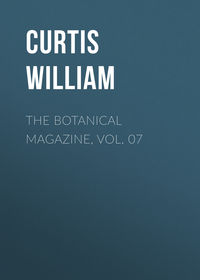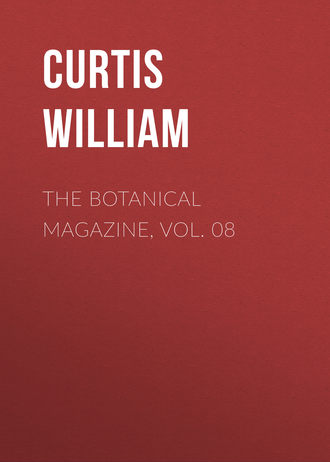 полная версия
полная версияThe Botanical Magazine, Vol. 08
We are induced to consider the rose here represented, as one of the most desirable plants in point of ornament ever introduced to this country; its flowers, large in proportion to the plant, are semi-double, and with great richness of colour unite a most delightful fragrance; they blossom during the whole of the year, more sparingly indeed in the winter months; the shrub itself is more hardy than most greenhouse plants, and will grow in so small a compass of earth, that it may be reared almost in a coffee cup; is kept with the least possible trouble, and propagated without difficulty by cuttings or suckers.
For this invaluable acquisition, our country is indebted to the late Gilbert Slater, Esq. of Knots-Green, near Laytonstone, whose untimely death every person must deplore, who is a friend to improvements in ornamental gardening: in procuring the rarer plants from abroad, more particularly from the East-Indies, Mr. Slater was indefatigable, nor was he less anxious to have them in the greatest perfection this country will admit; to gain this point there was no contrivance that ingenuity could suggest, no labour, no expence withheld; such exertions must soon have insured him the first collection of the plants of India: it is now about three years since he obtained this rose from China; as he readily imparted his most valuable acquisitions to those who were most likely to increase them, this plant soon became conspicuous in the collections of the principal Nurserymen near town, and in the course of a few years will, no doubt, decorate the window of every amateur.
The largest plants we have seen have not exceeded three feet, it may no doubt be trained to a much greater height; a variety of it much more robust, having usually several flowers on a footstalk, of a pale red colour, and semi-double also, has more lately been introduced, and as far as we can learn from the same source.
[285]
Jasminum Odoratissimum. Sweetest Jasmine
Class and OrderDiandria MonogyniaGeneric CharacterCorolla hypocrateriformis. Bacca dicocca. Semina solitaria, arillata.
Specific Character and SynonymsJASMINUM odoratissimum foliis alternis obtusiusculis ternatis pinnatisque, ramis teretibus, laciniis calycinis brevissimis. Ait. Hort. H. v. 1. p. 10. Linn. Syst. Veget. ed. 14. Murr. p. 56.
JASMINUM flavum odoratum. Barr. Ic. 62.
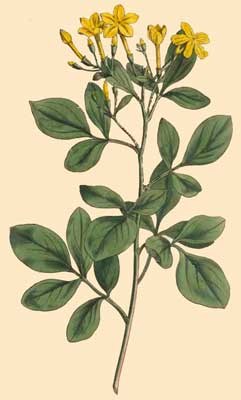
No285.
The flowers of most of the species of Jasmine are odoriferous, trivial names therefore expressive of this quality are ineligible, as wanting character; the present name is peculiarly objectionable, inasmuch as several other species are greatly superior to this in point of fragrance; a lesson for Botanists to abstain from trivial names of the superlative degree, such as odoratissimum, fœtidissimum, maximum, minimum, &c.
The present species, according to Mr. Aiton, is a native of Madeira, and was cultivated by Mr. Miller, in 1730; it is now a plant common in most greenhouses: it will form a shrub of considerable size, which requires no support; its leaves are glossy, inclining to yellow, growing for the most part three together, sometimes pinnated; its blossoms, which are yellow, make their appearance from May to November: in point of hardiness it is superior to many greenhouse plants, and may be propagated without difficulty by cuttings.
[286]
Portlandia Grandiflora. Great-Flowered Portlandia
Class and OrderPentandria MonogyniaGeneric CharacterCor. clavato-infundibuliformis. Antheræ 4-6. longitudinales. Caps. 5-gona, 2-valvis, retusa, 2-locularis, polysperma, coronata calyce 5-phyllo.
Specific Character and SynonymsPORTLANDIA grandiflora floribus pentandris. Linn. Syst. Veg. ed. 14. Murr. p. 213. Ait. Kew. v. 1. p. 228. foliis ovatis. Syst. Nat. ed. 13. Gmel. p. 360.
PORTLANDIA grandiflora floribus pentandris, capsulis ovatis, foliis oblongis acuminatis. Swartz. Obs. Bot. p. 69.
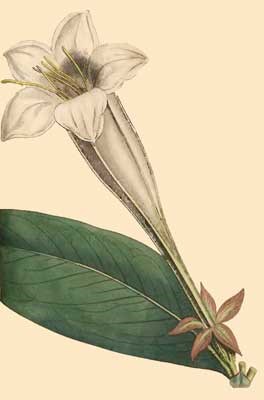
No286.
Dr. Brown, in his Natural History of Jamaica, gives to this genus the name of Portlandia, in honour of the Duchess Dowager of Portland, who employed many of the leisure hours of a long and happy life, in the pursuits of natural history, in which she was eminently skilled.—She was the friend and patron of Mr. Lightfoot, who dedicates to her his Flora Scotica; the fine collection of rare and valuable trees and shrubs which enrich part of the grounds at Bulstrode, were of her planting.
Dr. Swartz, in his Observations on the Plants of the West-Indies, informs us, that this species grows wild in Jamaica, where (incolit calcareosa petrosa) it inhabits calcareous rocky places3, forms a small tree about the height of six feet, and flowers from the middle of Summer to Autumn; its bark, he observes, as in other plants of the same genus, is extremely bitter.
From Mr. Aiton we learn, that it was introduced here by – Ellis, Esq. in 1775.
It forms a very beautiful stove plant, not of difficult growth, and readily disposed to flower; we have seen blowing plants of it little more than a foot high; its blossoms are not only uncommonly large, shewy, and curious in their structure, but fragrant also, and very much so when dried.
It is usually increased by cuttings.
[287]
Goodenia Lævigata. Smooth Goodenia
Class and OrderPentandria MonogyniaGeneric CharacterFlores monopetali, superi. Caps. bilocularis. Cor. supra longitudinaliter fissa, stigma urceolatum ciliatum. Smith Trans. Linn. Soc. v. 2. p. 346.
Specific CharacterGOODENIA lævigata foliis obovato-lanceolatis dentatis glabris.
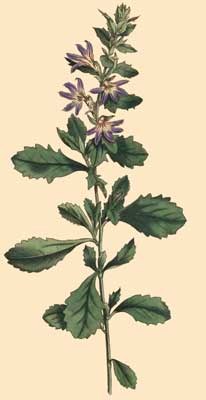
No287.
In the Autumn of 1792, Samuel Tolfrey Esq. most kindly invited me to inspect a vast number of the natural productions of Botany-Bay, in his possession; collected with great assiduity, and brought over in high preservation by Captain Tench; among other curiosities, he shewed me specimens of the earths of that country, imported in very small bags. I suggested to Mr. Tolfrey, that those earths might possibly contain the seeds of some curious and unknown plants; he readily acquiesced in the idea, and permitted me to make trial of them: accordingly, in the Spring of 1793, I exposed them in shallow pans, on a gentle tan heat, keeping them duly watered; in the course of the Summer they yielded me fourteen plants, most of which were altogether new, and among others the species of Goodenia here figured; this we have since found to be a hardy greenhouse plant, flowering from July to October, and very readily increased by cuttings.
The oldest plant in our possession is about a foot and a half high, much branched, the stalks are round and smooth to the naked eye, green below, above purplish, the leaves are smooth, a deep bright green colour, alternate, standing on footstalks, which gradually widen into the leaves, somewhat ovate, and deeply toothed; the flowers grow in the alæ of the leaves, forming a thin spike, they are sessile, of a pale violet colour, and have a peculiar smell which is rather unpleasant; at the side of each flower are two long narrow Bracteæ; the Calyx, which is placed on the germen, is composed of five short ovate leaves, which appear edged with hairs if magnified; the Corolla is monopetalous, the lower part, which at first is tubular, splits longitudinally above, and forms a kind of half tube, the edges of which are brown, the inside yellow, the outside greenish, the mouth beset with short hairs, each of which is terminated by a small villous head; the limb is deeply divided into five linear segments, spreading out like a hand, and terminated by short points; the Filaments are five in number, of a whitish colour, somewhat broadest above, rather flat, inserted into the receptacle; Antheræ oval, flattened, yellow, bilocular, a little bent, the length of the pistillum; but this is to be understood of such flowers as are not yet fully expanded, in those that are, they are much shorter, and appear withered; the Style, in flowers about to open, the length of the filaments, upright, in those that are opened much longer, and bent somewhat downward; Stigma at first upright, in the form of a cup, having the edge curiously fringed with white hairs, afterwards it closes together, loses its hollow, and assumes a flat appearance, and nods somewhat, the back part of it is bearded; Germen beneath the calyx, oblong, usually abortive with us.
The name of Goodenia has been given to this genus by Dr. Smith, in honour of the Rev. Samuel Goodenough, LL. D. of Ealing, my much-honoured friend, whose name will be ever dear to Botanists for his laborious investigation of the British Carices4.
[288]
Passiflora Ciliata. Fringed-Leaved Passion-Flower
Class and OrderGynandria HexandriaGeneric CharacterCal. 5-phyllus. Petala 5. Stamina germini vicina. Nectarium multi-radiatum. Antrum pedicellatum duplicatum 1-loculare.
Specific Character and SynonymsPASSIFLORA ciliata foliis trilobis glabris ciliato serratis intermedio longissimo, petiolis eglandulosis. Ait. Kew. v. 3. p. 310.
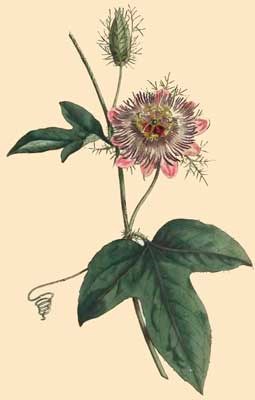
No288.
This Passion-Flower is described in the Hort. Kew. as a new one, under the name of ciliata, introduced by Mrs. Norman, from the West-Indies, in 1783: we saw it during the latter part of the last Summer, with great profusion of flowers, in several collections, more particularly in that of Mr. Vere, Kensington-Gore, from whence our figure and description were taken.
Its stalks are round, perfectly smooth, and run to a very great height; leaves dark green, glossy, perfectly smooth, except on the edges, where they are beset with strong glandular hairs, divided into three large and two small lobes, the middle lobe running out to a considerable length, the footstalks of the leaves are beset with a few hairs thinly scattered, at the base of each leaf is a tendril, and two finely-divided stipulæ, edged also with glandular hairs. The Involucrum is composed of three leaves, dividing into capillary segments, each of which terminates in a viscid globule, fetid when bruised; betwixt the involucrum and the blossom is a short peduncle; the pillar which supports the germen is of a bright purple colour, with spots of a darker hue, the germen is smooth and green; Styles green; Stigmata of a dark green; Filaments six in number; Antheræ pale yellow green, the former dotted with purple; of Radii, there may be said to be four rows, variegated with white and purple, petals ten, externally greenish, internally red, deeper or paler according to circumstances.
The leaves of this plant vary greatly in form, according to the health and luxuriance of the plant; on comparing it with the fœtida, we strongly suspect it to be a variety merely of that species: time will shew.
It is increased by cuttings, or seeds.
1
In honorem Licent. Thomæ Lopez, Burgensis, qui aliquot annos Regii Senatoris munere functus in America, Carolo V. imperante. In patriam reversus breviarium historiæ naturalis novi orbis scripsit sub titulo de tribus elementis aëre, aqua, et terra, MS. apud eundem Muguozium.
2
What the use of this very extraordinary apparatus may be we can at present scarcely conjecture, future observation may perhaps enable us to speak more decisively; when we figure the Diosma ericoides we shall probably have more to say of this species.
3
We wish that every person who describes foreign plants on the spot, would do thus; it would greatly facilitate their culture.
4
Vide a Dissertation on the British species of Carex, by Dr. Goodenough, in the second volume of the Transactions of the Linnean Society.




